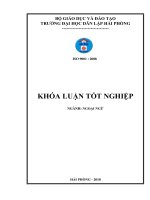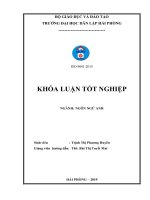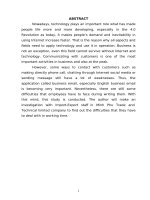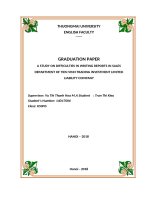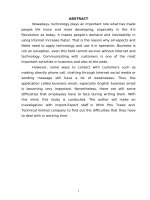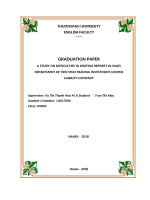a study on difficulties in writing business correspondence for major english students of foreign languages faculty of academy of finance
Bạn đang xem bản rút gọn của tài liệu. Xem và tải ngay bản đầy đủ của tài liệu tại đây (329.46 KB, 73 trang )
MINISTRY OF FINANCE
ACADEMY OF FINANCE
FOREIGN LANGUAGE FACULTY
GRADUATION THESIS
A STUDY ON DIFFICULTIES IN WRITING
BUSINESS CORRESPONDENCE FOR MAJOR ENGLISH STUDENTS
OF FOREIGN LANGUAGES FACULTY OF ACADEMY OF FINANCE
MINISTRY OF FINANCE
ACADEMY OF FINANCE
FOREIGN LANGUAGE FACULTY
Student: DAM HONG LOAN
Class: CQ47/51.03
A STUDY ON DIFFICULTIES IN WRITING
BUSINESS CORRESPONDENCE FOR MAJOR ENGLISH STUDENTS
OF FOREIGN LANGUAGES FACULTY OF ACADEMY OF FINANCE
GRADUATION THESIS
DECLARATION
I hereby declare that this thesis is my own work and effort and that it has
not been submitted anywhere for any award. Where other sources of information
have been used, they have been acknowledged.
Author
ACKNOWLEDGEMENT
This thesis would not have been possible without the support of many
people.
First of all, I would like to thank Management Board of Foreign
Languages Faculty for giving me a great opportunity to make a research on the
subject of writing business correspondence skill.
My thanks also go to all lectures of Foreign Languages Faculty who taught
me many valuable lessons on English in general and writing skill in particular.
I especially would like to express my grateful thanks to my respected
supervisor – Mr Cao Xuan Thieu, Head of Foreign Languages Faculty, Academy
of Finance for his continuous guidance and support without which my project
would not be completed.
.
LIST OF ABBREVIATIONS
FFL: Foreign Languages Faculty
LIST OF TABLES AND FIGURES
Table 1:
Difficult items in writing business correspondence
Figure 1:
Difficulty
levels
of
using
grammar
in
writing
business
correspondence
Figure 2:
Difficulty levels of using Lexis in writing business letter
Figure 3:
Difficulty levels of using Terminology in writing business letter
Figure 4:
Difficulty level of Setting expression and using words in writing
business letter
TABLE OF CONTENT
Acknowledgement
List of abbreviations
List of tables and figures
INTRODUCTION
1. Rationale of the study..................................................................................1
2. Aims of the study..........................................................................................2
3. Methods of the study....................................................................................2
4. Scope of the study.........................................................................................3
5. Structure of the study..................................................................................3
6. Significance...................................................................................................3
CHAPTER 1 – LITERATURE REVIEW.........................................................4
1.1 Introduction................................................................................................4
1.2 Background Knowledge of Business Correspondence............................4
1.2.1 The meaning of Business Correspondence........................................5
1.2.2 The importance of Business Correspondence....................................5
1.2.3 Types of Business Letter......................................................................7
1.3 Essential Qualities of A Good Business Letter.......................................11
1.3.1 Inner Qualities...................................................................................12
1.3.2 Outer Qualites....................................................................................13
1.4 Parts of A Business Letter......................................................................14
1.4.1 Heading..............................................................................................14
1.4.2 Date....................................................................................................14
1.4.3 Reference............................................................................................14
1.4.4 Inside Address....................................................................................15
1.4.5 Subject................................................................................................15
1.4.6 Salutation...........................................................................................15
1.4.7 Body of the letter................................................................................15
1.4.8 Complementary close.........................................................................16
1.4.9 Signature............................................................................................16
1.4.10 Enclosures........................................................................................17
1.4.11Copy Circulation...............................................................................17
1.4.12 Post script.........................................................................................17
1.5 Summary...................................................................................................18
CHAPTER 2 – METHODS AND PROCEDURES.........................................20
2.1 Introduction..............................................................................................20
2.2 The objective of the survey......................................................................20
2.3 Subjects.....................................................................................................20
2.4 Methodology and Method of the survey................................................21
2.4.1 Methodology.....................................................................................21
2.4.2 Method................................................................................................21
2.5 Procedures................................................................................................21
2.6 Finding and Discussion............................................................................22
2.6.1 The findings......................................................................................22
2.6.2 Some difficulties and common mistakes in using grammar in
writing business letter.................................................................................23
2.6.3 Power of Lexis and Terminology, Setting expression and using
words in writing business letter..................................................................26
2.6.4 Mistakes and difficulties in Setting expression and using words in
writing business letter.................................................................................34
2.6.5 Difficulties in conveying the original writing styles ........................44
2.7 Summary.................................................................................................. 50
CHAPTER 3 - SUGGESTIONS.......................................................................51
3.1 Suggestions...............................................................................................51
3.1.1Limitations..........................................................................................51
3.1.2 Solutions.............................................................................................51
3.2 Suggestions for further study..................................................................56
CONCLUSION..................................................................................................58
REFERENCES...................................................................................................60
APPENDIX.........................................................................................................61
INTRODUCTION
*****
1. RATIONALE OF THE STUDY
English, like oxygen, is the essential thing in our daily life. It is one of the most
important languages in today's global world. It is the mother tongue of about two
hundred million people. There are more than three hundred million people speak
English as their first or native language. Another three hundred speak it as foreign
language. Therefore, it is used as a means of communication in everyday life,
especially in business.
Nowadays, due to the internationalization trend of the world economy, the
business world has need for the global language of English. Many companies not only
operate in their countries but also are expanding overseas. Therefore, people in
business world are learning English to break the language barrier somehow. This
makes it easier to broker deals or tell potential partners what is expected of them. It is
often the tradition of the business world that you need to know your potential partner's
mother tongue.
During the previous four years, I and my friends had chances to study English
thoroughly in terms of four skills practice (reading, listening, speaking and writing) as
well as English theory (English grammar, phonetics and phonology, semantics, and so
on). I would say that Intelligent Business is my most favorite subject since it teaches
me some skills such as writing memos, e-mail, letters that are essential for working in a
business world in the future. To keep in touch with partners, the best way is to use
business correspondence in English because more than three-forth of the world's mail
and business letter is written in English. Although business correspondence is easy to
understand, writing business correspondence well is not easy.
1
From the above reasons, it is, to my mind, an urgent need to prioritize in
proposing the common mistakes students usually face with when writing business
correspondence. Therefore, in my research, designing a study on difficulties in writing
business correspondence for major English students of Foreign Languages Faculty
of Academy of Finance really satisfies the need.
2. AIMS OF THE STUDY.
It has been easy to realize that business correspondence is an important tool for
business activities' communication or exchange information. That is why the minor
thesis is aimed to design a study on difficulties in writing business correspondence for
major English students of Foreign Languages Faculty of Academy of Finance. Further
more, the ambition of this thesis is to actively, effectively and directly contribute to the
further research, development and implementation of writing business correspondence.
The thesis can be seen as overall picture that help students to have a general view of
fundamental things about the skill and to explore the writing business correspondence
skill in other novices' point of view.
3. METHODS OF THE STUDY.
Writing business correspondence is a skill to be learned. In order to perform this
study, I firstly choose the method of analyzing, summarizing, and synthesizing
materials and books to perform the theoretical background. Besides, I also make use of
information from informal discussions with my teachers and my friends.
In the process of writing this paper, I also base myself on the knowledge,
suggestions and recommendations I have gained from my teachers, my supervisor and
from some references.
Last but not least, my awareness of writing business correspondence skill gained
from learning English at Foreign Language Faculty of Academy of Finance provide me
favorable conditions to the completion of the study.
2
4. SCOPE OF THE STUDY.
This thesis is a methodical investigation into the subject of writing business
correspondence; a focus and systematic request for information that may go beyond
generally available knowledge to acquire more in-depth analysis and elucidatory
comment on the topic. It's a product of a long searching process with a series of
activities unfolding overtime. It involves a number of things such as the collection of
data, the evaluation of results, and so on.
5. ORGANIZATION OF THE STUDY.
The study is divided into three parts:
The first part is the introduction dealing with the rationale, aims, methods, scope,
organization, and significance of the study.
The second part is the main part of the paper with three chapters:
Chapter I states the review of literature. This chapter provides a general
overview of business correspondence.
Chapter II presents the research methods and procedures including the methods
adopted in doing the research, the selection of participants, the materials, the methods
of data collection and data analysis.
Chapter III is the results and discussion.
The last part is the conclusion summarizing the content of the paper and giving some
suggestions for further study.
6. SIGNIFICANCE
It is hoped that this study, to some extent, will be a useful reference material for FFL
students to get more ideas and techniques in improving their writing skill.
3
CHAPTER 1
LITERATURE REVIEW
*****
1.1 Introduction:
Literature review is an account of what has been published on a topic by
accredited scholars and researchers but not simply a new interpretation of old
material. Therefore, this chapter is intended not only to demonstrate relevant
information on writing business correspondence skill but also to provide
informed evaluation of the literature. This chapter explains various aspects
related to the topic of writing business correspondence in succession ranging
from general view to specific view. It is started with background knowledge of
business correspondence, types of business letters, then a focus on essential
qualities of a good business letter and the rest of the chapter completely zooms in
parts of a business letter.
1.2 Background knowledge of business correspondence:
In our day to-day life we exchange our ideas, thoughts and other information
with our friends, relatives and other people. Sometimes we directly talk to them and
sometimes we also write letters to them. In letters we express our feelings in a
few words, we may ask for any information or we may write about a complaint in
connection with our problems. Similarly businessmen also exchange ideas,
information by writing letters. They communicate business information to
customers, suppliers and others and at the same time receive a variety of letters
from them. There is a straightforward explanation of business correspondence
given by Merriam-Webster, Inc. can help even non-professionals have an overall
picture of what business correspondence is. It stated that "Business
4
correspondence is the communication or exchange of information in a written
format for the process of business activities. Business correspondence can take
place between organizations, within organizations or between the customers and
the organization. The correspondence is generally of widely accepted formats
that are followed universally".
1.2.1 The meaning of Business Correspondence:
Communication through exchange of letters is known as correspondence.
We communicate our feelings, thoughts etc. to our friends and relatives through
letters that may be called personal correspondence. A businessman also writes and
receives letters in his day to-day transactions, which may be called business
correspondence. Business correspondence or business letter is a written
communication between two parties. Businessmen may write letters to supplier of
goods and also receive letters from the suppliers. Customers may write letters to
businessmen to seek information about availability of goods, price, quality, sample etc.
or place order for purchase of goods. Thus, business letters may be defined as a media
or means through which views are expressed and ideas or information is
communicated in writing in the process of business activities.
1.2.2 The importance of Business Correspondence:
Nowadays business operations are not restricted to any locality, state or nation.
Today production takes place in one area but consumption takes place everywhere.
Since the businessmen as well as customers live in far off places they don't have
sufficient time to contact each other personally. Thus, there arises the need for writing
letters. In the past the situation was not so. Business letters were not essential in olden
days. But now the importance of letters has increased because of vast expansion of
business, increase in demand as well as supply of goods.
5
i) Help in maintaining proper relationship: Nowadays business activities are not
confined to any one area or locality. The businessmen as well as customers are scattered
throughout the country. Thus, there is a need to maintain proper relationship among them
by using appropriate means of communication. Here business letters play an important
role. The customers can write letters to the businessman to seek information about
products and businessmen also supply various information to customers. This helps
them carry on business on national and international basis.
ii)
Inexpensive and convenient mode: Though there are other modes of
communication like telephone, telex, fax, etc. but business information can be provided
and obtained economically and conveniently through letters.
iii) Create and maintain goodwill: Sometimes business letters are written to
create and enhance goodwill. Businessmen at times send letters to enquire about
complaints and suggestions of their customers. They also send letters to inform the
customers about the availability of a new product, clearance sale etc. This results in
cordial relations with the customers, which enhances the goodwill of the business.
iv) Serve as evidence: We cannot expect a trader to memorize all facts and
figures in a conversation that normally takes place among businessmen. Through
letters, he can keep a record of all facts. Thus, letters can serve as evidence in case of
dispute between two parties.
v) Help in expansion of business: Business requires information regarding
competing products, prevailing prices, promotion, market activities, etc. If the trader has
to run from place to place to get information, he will end up doing nothing. It will simply
result in loss of time. But through business letters, he can make all enquiries about the
products and the markets. He can also receive orders from different countries and, thus
enhance sales.
6
1.2.3 Types of Business Letters:
Business letters are written for the fulfillment of several purposes. The purpose
may be to enquire about a product to know its price and quality, availability, etc.
This purpose is served if you write a letter of enquiry to the supplier. After receiving
your letter the supplier may send you details about the product as per your query. If
satisfied, you may give order for supply of goods as per your requirement. After
receiving the items, if you find that the product is defective or damaged, you may lodge
a complaint. These are the few instances in which business correspondence takes place.
Some important business letters are the following:
i) Business Enquiry Letter: Sometimes prospective buyers want to know the
details of the goods which they want to buy, like quality, quantity, price, mode of
delivery and payment, etc. They may also ask for a sample. The letter written to sellers
with one or more of the above purposes is known as enquiry letters.
Sample of Business Enquiry Letter
Tel. 23241053
M/s Acron Electricals
Email:
Fax.:23244155
22/c, Main Road
Website: Fax
Darya Ganj, New Delhi-2
Ref. PR/F/2002/27
Dated: July 27,2002
M/s Bharat Fans
Bharat Complex
Hyderabad Industrial Estate
Hyderabad - 500032
Subject: Enquiry about the prices of
fans
Dear Sir,
We are dealing in retail trade of electrical appliances. We would be interested in selling your product, Bharat Fans
through our retail showroom.
Could you, therefore, send us your quotations and let us know the terms and conditions
of payment.
Thanking you,
Yours faithfully,
For M/s Acron Electricals
7
Sd/(A.B.Kumar)
Partner
ii) Quotation Letter: After receiving the letter of enquiry from a prospective
buyer, the sellers supply the relevant information by writing a letter that is called
quotation letter. These letters are written keeping in view the information asked for like
price list, mode of payment, discount to be allowed etc. Businessman should reply to
the inquiries carefully and promptly.
Sample of Quotation Letter
Tel. 508632-35
M/s Bharat Fans
E-mail:
Fax. 508600
Bharat Complex
Website:
Hyderabad Industrial Estate
Hyderabad - 500032
Ref.-SL/F/2002/12
Dated: August 10,2002
M/s Acron Electricals
22/c, Main Road
Darya Ganj, New Delhi-2
Subject: Your letter No. PR/F/2002/27 dated July 27, 2002
Dear Sir,
Thank you for your letter of enquiry. We would be glad to meet your requirements of selling our
fan in your retail showroom.
Our quotations are given in the price list enclosed. We offer 10% discount on order above Rs.
50,000. Besides, we allow a grace period of 45 days for payment of dues to our regular customers.
We are confident that you will find our prices competitive and our terms and conditions
reasonable. We look forward to meeting your requirements.
Thanking you,
Yours faithfully,
For M/s Bharat Fans
Sd/(Desgupta)
Sales manager
Encl: Price List & Terms and Conditions
8
iii) Order Letter: In the previous section, we have studied about letters of
enquiry and reply to enquiry i.e., quotation letter. The prospective buyer after
receiving the reply to his enquiry letter may decide to place on order with that business
house which offers goods at minimum price and at favorable terms and conditions.
Letters written by a buyer to the seller giving the order to purchase the goods is called
order letter.
Sample of Order Letter:
Tel. 3241053
M/s Acron Electricals
E-mail:
Fax.3244155
22/c, Main Road
Website:
Darya Ganj, New Delhi-2
Ref. PR/F/2002/32
Dated: August 22,2002
Subject: Your letter of quotation No. SL/F/2002/12 dated August 10,2002
Dear Sir,
Many thanks for your prompt reply to our enquiry letter of July 27, 2002. As we find your prices
and terms quite reasonable, we wish to place a trial order as per the list enclosed.
As pointed out in our enquiry letter, quality is important. Should the goods meet our expectations,
substantial orders will follow.
Payment will be made within the time limit prescribed in your quotation letter.
Thanking You,
Your faithfully,
For M/s Acron Electrical
Sd/(A.B.Kumar)
Partner
Encl: Order list
iv) Complaint Letter: A complaint letter is written when the purchaser does not
find the goods up to his satisfaction. It is normally written by the purchaser when he
/she receives wrong, defective or damaged goods or receives incorrect quantity of
goods. It can also be written directly to the transit authority when the goods are
damaged in transit. Thus, we may define a letter of complaint as the letter that draws the
attention of the supplier or any other party on account of supply of defective or
damaged goods.
9
Sample of Complaint Letter
Tel. 3241053
M/s Acron Electricals
E-mail:
Fax.3244155
22/c, Main Road
Website:
Darya Ganj, New Delhi-2
Ref. PR/F/2002/27
Dated: September 5, 2002
M/s Bharat Fans
Bharat Complex
Hyderabad Industrial Estate
Hyderabad - 500032
Subject: Complaint regarding fans
Dear Sir,
I would like to draw your attention to the fact that some fans are found missing in the parcel, dispatched by you,
which I received today. It appears that the following items were not included.
Bharat
fan
super
quality
3 (Three)
Bharat
fan
standard
2 (Two)
We will appreciate if the above fans are sent to us or the amount credited to our account.
Your faithfully,
For M/s Acron Electrical
Sd/(A.B.Kumar)
Partner
v) Recovery Letter: The letter written by the seller for collection of money for
the goods supplied to the buyer is called recovery letter. The aim of recovery letter is to
collect money without annoying the customers. The letter should include information
regarding the amount of arrears argument for payment, and last date for payment. The
language of recovery letter should be polite, so that the customer is not offended and
future transactions with him are not adversely affected.
Sample of Recovery Letter
Tel. 508632-35
M/s Bharat Fans
E-mail:
10
Fax. 508600
Bharat Complex
Website:
Hyderabad Industrial Estate
Hyderabad - 500032
Ref.-SL/F/2002/12
Dated: December 10,2002
M/s Acron Electricals
22/c, Main Road
Darya Ganj, New Delhi-2
Subject: Recovery of dues
Dear Sir,
We believe that the payment of our bill No. 1713 dated September 2,2002 must have escaped your attention. As
the payment is due since long, we would appreciate if you send us your cheque immediately. Please let us know
whether payment is being withheld for some special reasons.
Thanking you,
Yours faithfully,
For M/s Bharat Fans
Sd/(Desgupta)
Sales manager
1.3 Essential Qualities of A Good Business Letter:
A letter should serve the purpose for which it is written. If a businessman
writes a letter to the supplier for purchase of goods, the letter should contain all
the relevant information relating to the product, mode of payment, packaging,
transportation of goods, etc. clearly and specifically. Otherwise, there will be
confusion that may cause delay in getting the goods. Again the qualities of paper
used in the letter, its size, color, etc also need special attention, because it creates a
positive impression in the mind of the receiver. The qualities of a good business
letter are classified as: Inner qualities and Outer qualities
11
1.3.1 Inner Qualities: The inner qualities of a good business letter refer to
the quality of language, its presentation, etc. These facilitate quick processing of the
request and that leads to prompt action. The inner qualities of a good business
letter vary:
i) Simplicity - Simple and easy language should be used for writing business
letters. Difficult words should be strictly avoided, as one cannot expect the reader to refer
to the dictionary every time while reading letter.
ii) Clarity - The language should be clear, so that the receiver will understand
the message immediately, easily and correctly. Ambiguous language creates
confusion. The letter will serve the purpose if the receiver understands it in the same
manner in which it is intended by the sender.
iii) Accuracy - The statements written in the letter should be accurate to, the best
of the sender's knowledge. Accuracy demands that there are no errors in the usage of
language - in grammar, spellings, punctuations etc. An accurate letter is always
appreciated.
iv) Completeness - A complete letter is one that provides all necessary
information to the users. For example, while sending an order we should mention the
desirable features of the goods, i.e., their quality, shape, color, design, quantity, date of
delivery, mode of transportation, etc.
v) Relevance - The letter should contain only essential information. Irrelevant
information should not be mentioned while sending any business
correspondence.
vi) Courtesy - Courtesy wins the heart of the reader. In business letters,
courtesy can be expressed by using words like please, thank you, etc.
vii) Neatness - A neat letter is always impressive. A letter either handwritten
or typed, should be neat and attractive in appearance. Overwriting and cuttings
12
should be avoided.
1.3.2 Outer Qualities - The outer qualities of a good business letter refers
to the appearance of the letter. It includes the quality of paper used, color of the
paper, size of the paper etc. Good quality paper gives a favorable impression in
the mind of the reader. It also helps in documenting the letters properly. There
are various outer qualities of a good business letter.
i) Quality of paper - The paper used should be in accordance with the
economic status of the firm. Nowadays the cost of the paper is very high.
Therefore, good paper should be used for original copy and ordinary paper may
be used for duplicate copy.
ii) Color of the Paper - It is better to use different colours for different
types of letters, so that the receiver will identify the letters quickly and prompt
action can be taken.
iii) Size of the paper - Standard size paper (A4) should be used while
writing business letters. The size of the paper should be in accordance with the
envelopes available in the market.
iv) Folding of letter- The letter should be folded properly and uniformly.
Care should be taken to give minimum folds to the letter so that it will fit the size
of the envelope. If window envelope is used then folding should be done in such
a way that the address of the receiver is clearly visible through the transparent part
of the envelope.
v) Envelope - The size and quality of the envelope also need special attention.
The size of the letter should fit the size of the letters. The business firms use different
types of envelopes i.e., ordinary envelope, window envelope, laminated envelope etc. In
window envelope there is no need to write the address of the receiver separately on
the envelope. It is clearly visible through the transparent part on the face of the
13
envelope, which may be called as window. In laminated envelope a thin plastic sheet or
cloth is pasted on the inner side that gives extra protection to letters from being
damaged during transit.
1.4 Part of A Business Letter:
The quality of a good business letter will be maintained if we give proper
attention to each and every part of the letter. There are some different parts of a business
letter. The essential parts of a business letter are as follows:
1.4.1 Heading -The heading of a business letter usually
contains the name and postal address of the business, E-mail
address, Web-site address, Telephone Number, Fax Number, Trade
Different parts of a
business letter-
1. Heading
2. Date
3. Reference
Mark or logo of the business (if any)
4. Inside Address
1.4.2. Date - The date is normally written on the right hand side
corner after the heading as the day, month and years. Some examples
are 28 Feb., 2003 or Feb. 28, 2003.
th
5. Subject
6. Salutation
7. Body of the letter
8. Complimentary
1.4.3. Reference- It indicates letter number and the
department from where the letter is being sent and the year. It helps
close
9. Signature
10. Enclosures
in future reference. This reference number is given on the left hand
11. Copy Circulation
corner after the heading. For example, we can write reference number
12. Post Script
as AB/FADept./2003/27.
1.4.4. Inside address - This includes the name and full address of the person or the
firm to whom the letter is to be sent. This is written on the left hand side of the sheet below the
reference number. Letters should be addressed to the responsible head e.g., the
Secretary, the Principal, the Chairman, the Manager etc. Example:
M/S Bharat Fans
The Chief Manager, State
Bharat Complex
Bank of India
Hyderabad Industrial Complex
Utkal University Campus
14
Hyderabad
Bhubaneswar,
Andhra Pradesh - 500032
751007
Orissa-
1.4.5. Subject - It is a statement in brief, that indicates the matter to which
the letter relates. It attracts the attention of the receiver immediately and helps him
know quickly what the letter is about. For example,
Subject: Your order No. C317/8 dated 12th March 2003.
Subject: Enquiry about Samsung television
Subject: Fire Insurance policy
1.4. 6. Salutation - This is placed below the inside address. It is usually
followed by a comma (,). Various forms of salutation are:
Sir/Madam: For official and formal correspondence
Dear Sir/Madam: For addressing an individual
Dear Sirs/Dear Madam: For addressing a firm or company
1.4.7. Body of the letter- This comes after salutation. This is the main part
of the letter and it contains the actual message of the sender. It is divided into three
parts.
i) Opening part - It is the introductory part of the letter. In this part, attention of
the reader should be drawn to the previous correspondence, if any. For example- with
reference to your letter no. 326 dated. 12 th March 2003, I would like to draw your
attention towards the new brand of television.
ii) Main part - This part usually contains the subject matter of the letter. It
should be precise and written in clear words.
iii) Concluding Part - It contains a statement the of sender's intentions, hopes
or
15
expectations concerning the next step to be taken. Further, the sender should always
look forward to getting a positive response. At the end, terms like Thanking you, With
regards, With warm regards may be used.
1.4.8. Complimentary close - It is merely a polite way of ending a letter. It must
be in accordance with the salutation. For example:
Salutation
i.) Dear Sir/Dear Madam
ii) Dear Mr. Raj
iii) My Dear Akbar
Complementary close
Yours faithfully
Yours sincerely
Yours very sincerely (express very informal
relations)
1.4.9. Signature - It is written in ink, immediately below the complimentary
close. As far as possible, the signature should be legible. The name of the writer
should be typed immediately below the signature. The designation is given below the
typed name. Where no letterhead is in use, the name of the company too could be
included below the designation of the writer. For example:
Yours faithfully
For M/S Acron Electricals
(Signature)
SUNIL KUMAR
Partner
1.4.10. Enclosures - This is required when some documents like cheque,
draft, bills, receipts, lists, invoices etc. are attached with the letter. These
enclosures are listed one by one in serial numbers. For example :
Encl: (i) The list of goods received
(ii) A cheque for Rs. One Thousand dtt. Feb. 27,2003 (Cheque
No........) towards payment for goods supplied
16
